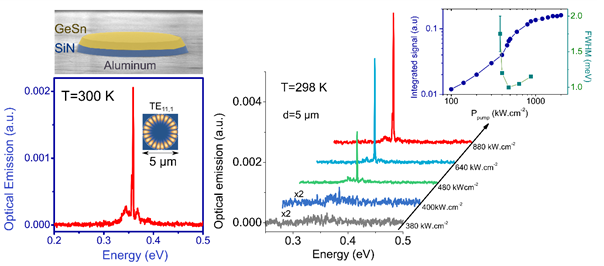First Room temperature GeSn laser
GeSn alloys are the most promising direct band gap semiconductors to demonstrate full CMOS-compatible laser integration with a manufacturing from Group-IV materials. An important milestone towards real-field applications is the ability to operate at room temperature (RT). So far, the highest temperatures achieved for laser operation with GeSn were 273 K at prohibitive power threshold densities of several MW/cm2. Here, we show for the first time that room temperature and above, up to 300 K, lasing can be obtained with GeSn. In addition the threshold densities are reduced to few hundreds of kW/cm2. This is achieved in microdisk resonators fabricated on a GeSn-On-Insulator platform that combine strain engineering with a thick layer of high Sn content GeSn. As previously detailed in recent publication [1] the main assets of this specific laser technologies are, first, to enable the removal of interfacial defect, second, to improve the optical confinement in the gain region as compared to conventional approach based on as grown GeSn /Ge buffer stacks on silicon. Third, the strain transfer from the insulator yields a higher directness of the band structure of the alloy and more robust gain then. Finally the whole structure is fabricated on an aluminum heat sink for improved thermal cooling of the gain media.
This achievement published in [2] open the route to real field application of CMOS-compatible Mid-infrared lasers. This work has been developed in a collaboration between C2N-University-Paris-Saclay-CNRS and CEA in Grenoble (LETI and IRIG) with STMicroelectronics.
[1] "GeSnOI mid-infrared laser technology"
B. Wang, E. Sakat, E. Herth, M. Gromovyi, A. Bjelajac, J. Chaste, G. Patriarche, P. Boucaud, F. Boeuf, N. Pauc, V. Calvo, J. Chrétien, M. Frauenrath, A. Chelnokov, V. Reboud, J.-M. Hartmann, M. El Kurdi
Light: Science & Applcaitions 10, 232 (2021)
https://www.nature.com/articles/s41377-021-00675-7
[2] "Up to 300 K lasing with GeSn-On-Insulator microdisk resonators"
A. Bjelajac, M. Gromovyi, E. Sakat, B. Wang, G. Patriarche, N. Pauc, V. Calvo, P. Boucaud, F. Boeuf, A. Chelnokov, V. Reboud, M. Frauenrath, J.-M. Hartmann, M. El Kurdi
Optics Express 30, 3954-3961 (2022)
https://opg.optica.org/oe/fulltext.cfm?uri=oe-30-3-3954&id=468657
